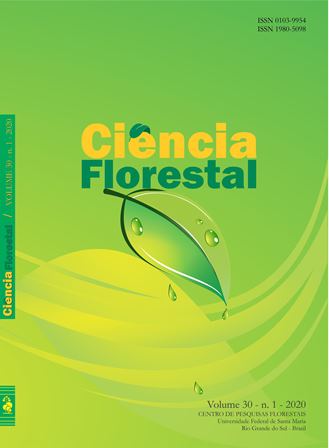Potential of the use of four bamboo species for the production of charcoal for home use
DOI:
https://doi.org/10.5902/1980509827348Keywords:
Proximate analysis, Gross calorific value, Bulk density, Gravimetric yieldAbstract
The use of bamboo stems can be an important alternative for expanding renewable sources for bioenergy production, including for charcoal production. Therefore, the aim of this research was to evaluate the potential of four bamboo species for the production of charcoal for home use, as a way to promote the multiple use of this raw material and to generate additional income for the family farmers of Santa Catarina state. Five individuals of the species Bambusa vulgaris, collected in Florianópolis, and Phyllostachys bambusoides; Phyllostachys edulis; Phyllostachys nigra were collected in the municipality of Frei Rogério, Santa Catarina. The analyses of the basic density of the in natura stems, the physical properties, gravimetric yield and energetic properties of the charcoal were carried out in the basal, median and top portions of the bamboo stems of each species. The quality of the charcoal varied among the bamboo species, having as the only negative point the high ash content for home use charcoal. There was a high positive correlation between the basic density of the stem and the apparent relative density of charcoal. The species B. vulgaris presented the highest yield in the productive process, but it generated lighter charcoal and with lower energy performance. Among the evaluated species, Phyllostachys nigra was the species that produced the charcoal with the best energetic quality and with good physical properties and gravimetric yield. The quality of the charcoal varies with respect to the height of the stem. The top of the stems, which is the residue that can be destined for the production of charcoal in commercial plantations of bamboo for multiple uses, presented greater yield in the productive process and charcoal with greater density. However, the energetic quality of the charcoal was inferior in relation to the base and median position of the stems.Downloads
References
AMERICAN SOCIETY FOR TESTING AND MATERIAL. ASTM 1762: Standard Test Method for Chemical Analysis of Wood Charcoal. West Conshohocken, 2013. 2 p.
ANDRADE, J. K. B. et al. Productive potential of species Bambusa vulgaris Schrad. charcoal grown in Timon, Ma. Revista Verde, Pombal, v. 10, n. 3, p. 29-33, 2015.
ASSOCIAÇÃO BRASILEIRA DE NORMAS TÉCNICAS. NBR 11941: Madeira - Determinação da densidade básica. Rio de Janeiro, 2003a. 6 p.
ASSOCIAÇÃO BRASILEIRA DE NORMAS TÉCNICAS. NBR 14929: Madeira - Determinação do teor de umidade de cavacos - Método por secagem em estufa. Rio de Janeiro, 2003b. 3 p.
BAZ, R. J. Q. et al. Physico-chemical properties of bamboo charcoals from species Bambusa vulgaris var vittatta, Dendrocalamus asper and Phyllostachys pubescens. Revista Brasileira de Energias Renováveis, Curitiba, v. 8, n. 3, 2019.
BERNDSEN, R. S. et al. Propriedades físicas do bambu-mossô (Phyllostachys pubescens Mazel ex H. de Lehaie) em diferentes idades e posições do colmo. Floresta, Curitiba, v. 40, n. 1, p. 183-192, jan./mar. 2010.
BRAND, M. A. et al. Qualidade do carvão vegetal para o consumo doméstico comercializado na região serrana sul de Santa Catarina. Revista Árvore, Viçosa, MG, v. 39, n. 6, p. 1165-1173, 2015.
BRASIL. Lei nº 12.484 8 de setembro de 2011. Disponível em: https://www.planalto.gov.br/ccivil_03/_ato2011-2014/2011/lei/l12484.htm. Acesso: 12 Jun. 2015.
CAMPOS, R. F. et al. Espécies exóticas de bambu no município de São Mateus do Sul, Paraná. Cadernos de Agroecologia, Pelotas, v. 11, n. 2, dez. 2016.
DEUTSCHES INSTITUT FÜR NORMUNG. DIN 51900: determining the gross calorific value of solid and liquid fuels using the bomb calorimeter, and calculation of net calorific value. Berlim, 2000. 7 p.
GUERRA, S. P. S. et al. Mechanized harvesting of bamboo plantations for energy production: Preliminary tests with a cut-and-shred harvester. Energy for Sustainable Development, Portland, v. 34, p. 62-66, 2016.
INTERNATIONAL NETWORK FOR BAMBOO AND RATTAN. Can bamboo transform bioenergy? 15 oct. 2014. Disponível em: http://www.inbar.int/2014/10/can-bamboo-transform-bioenergy/. Acesso em: 12 jun. 2015.
LIU, Z.; FEI, B.; JIANG, Z. Combustion characteristics of bamboo-biochars. Bioresource Technology, Lucknow, v. 167, p. 94-99, 2014.
MARAFON, A. C.; AMARAL, A. F. C.; LEMOS, E. E. P. Caracterização de espécies de bambu e outras biomassas com potencial para a geração de energia térmica. Pesquisa Agropecuária Tropical, Goiânia, v. 49, p. e55282-e55282, 2019.
MELO, R. R. de et al. Physical mechanical properties of wood-bamboo particleboard. Ciência Rural, Santa Maria, v. 45, n. 1, p. 35-42, jan. 2015.
NEVES, T. A. et al. Avaliação de clones de Eucalyptus em diferentes locais visando à produção de carvão vegetal. Pesquisa Florestal Brasileira, Colombo, v. 31, n. 68, p. 319, 2011.
OYEDUN, A. O.; GEBREEGZIABHER, T.; HUI, C. W. Mechanism and modelling of bamboo pyrolysis. Fuel processing technology, Western Australia, v. 106, p. 595-604, 2013.
PEREIRA NETO, J. S. et al. Aplicação do bambu nas construções rurais. Revista Educação Agrícola Superior, Campina Grande, v. 24, n. 2, p. 67-77, 2009.
RAMBO, M. K. D.; SCHMIDT, F. L.; FERREIRA, M. M. C. Analysis of the lignocellulosic components of biomass residues for biorefinery opportunities. Talanta, Seattle, v. 144, p. 696-703, 2015.
SANTANA, G. M. et al. Carvão ativado a partir de resíduos de bambu (Bambusa vulgaris) utilizando CO2 como agente ativante para adsorção de azul de metileno e fenol. Ciência Florestal, Santa Maria, v. 29, n. 2, p. 769-778, 2019.
SANTOS, R. C. dos et al. Correlações entre os parâmetros de qualidade da madeira e do carvão vegetal de clones de eucalipto. Scientia Forestalis, Piracicaba, v. 39, n. 90, p. 221-230, 2011.
SÃO PAULO (Estado). Secretaria de Agricultura e Abastecimento de São Paulo. Resolução n°10 SAA, de 11 de julho de 2003. São Paulo, 2003.
TOMBOLATO, A. F. C.; GRECO, T. M.; PINTO, M. M. Dez espécies de bambus exóticos mais comuns no paisagismo no Brasil. Revista Brasileira de Horticultura Ornamental, Campinas, v. 18, n. 2, p. 105-114, 2012.
VALE, A. T.; MOREIRA, A. C. O.; MARTINS, I. S. Avaliação do potencial energético de Bambusa vulgaris em função da idade. Floresta e Ambiente, Rio de Janeiro, v. 24, p. 1-9, 2017.







